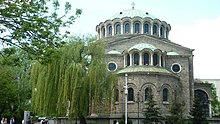Saint Nedelya Church
| Holy Nedelya Church | |
|---|---|
 |
|
| Basic information | |
| Location | pl. Sveta Nedelya, Sofia, Bulgaria |
| Geographic coordinates | 42°N 23°E / 42°N 23°ECoordinates: 42°N 23°E / 42°N 23°E |
| Affiliation | Bulgarian Orthodox Church |
| Territory | Diocese of Sofia |
| Region | Bulgarian Patriarchate |
| Year consecrated | 10th century / 1867 / 1933 |
| Ecclesiastical or organizational status | cathedral |
| Architectural description | |
| Architect(s) | Ivan Vasilyov (current building) |
| Architectural style | Byzantine Revival architecture |
Holy Sunday Church (Bulgarian: църква „Света Неделя“ Sveta Nedelya) is an Eastern Orthodox church in Sofia, the capital of Bulgaria, a cathedral of the Sofia bishopric of the Bulgarian Patriarchate. Sveta Nedelya is a medieval church that has suffered destruction through the ages and has been reconstructed many times. The present building of the temple is among the landmarks of Sofia. It was designed by the famous Bulgarian architectural team Vasilyov-Tsolov.
The history of the cathedral's earliest years is to a large extent unknown. It was probably built in the 10th century and had stone foundations and an otherwise wooden construction, remaining wooden until the middle of the 19th century, unlike most other churches in the city. A German traveller by the name of Stefan Gerlach visited Sofia in 1578 and mentioned the church.
Around 1460, the remains of Serbian king Stefan Milutin were carried to Bulgaria and were stored in various churches and monasteries until being transferred to St Nedelya after it became a bishop's residence in the 18th century. With some interruptions, the remains have been preserved in the church ever since and the church acquired another name, Holy King („Свети Крал“, „Sveti Kral“), in the late 19th and early 20th century.
The former building was demolished to make place for a larger and more imposing cathedral on 25 April 1856. The construction of the 35.5 m-long and 19 m-wide church began in the summer of the same year. The still incomplete building suffered from an earthquake in 1858, which prolonged the construction works that ultimately finished in 1863. It was officially inaugurated on 11 May 1867 in the presence of 20,000 people. A new belfry was erected to accommodate the 8 bells given to the church as a present by Russian Knyaz (Prince) Dondukov-Korsakov in 1879.
The church was renovated in 1898, with new domes being added. Exarch Joseph I of Bulgaria was buried immediately outside the walls of St Nedelya in 1915. The church was razed in the assault in 1925 that claimed over 150 victims. After the assault, the church was restored to its modern appearance between the summer of 1927 and the spring of 1933 (once again inaugurated on 7 April 1933). It was almost erected anew as a temple 30 m in length and 15.50 m in width and featuring a central dome that made it 31 m high. The gilt iconostasis that survived the bomb attack was returned to the church.
...
Wikipedia
